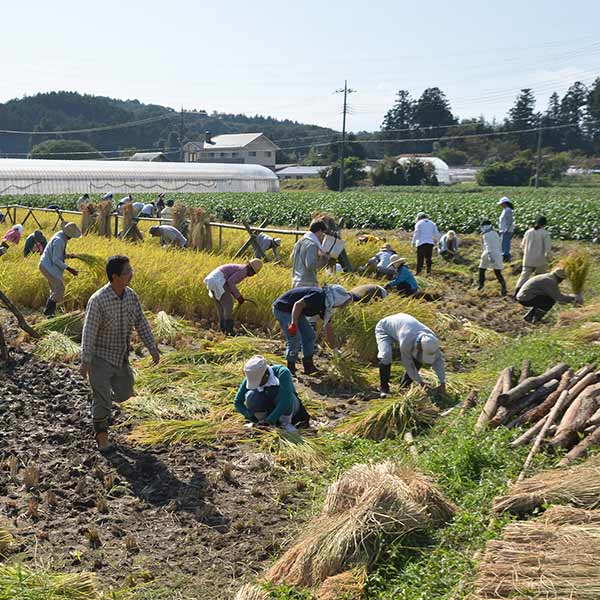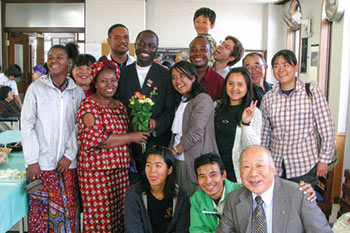Subtotal: $
Checkout-

Nature through a Child’s Eyes
-

Building the Muscles of Forgiveness
-

Learning to Love Boko Haram
-

Insights on Witness to the Gospel
-

The Upside-Down Church
-

Everyone Belongs to God - a Reading
-

Waiting to be Welcomed
-

Clinic of the Great Physician
-

Equipped with Water, Flip-flops, and Prayer
-

No Time for Silence
-

Marriage under Christ
-

What Is Marriage For?
-

After Obergefell
-

A Colony of Heaven: The Church in Dissent
-

Pursuing Jesus
-

Digging Deeper: Issue 6
-

Poem: A Fly from the Early Anglers
-

And This Amazing Blue
-

Editors’ Picks Issue 6
-

Featured Books from Plough: Autumn 2015
-

From Khirbet Khizeh to Lod
-

The Witness of Jesus
-

Readers Respond: Issue 6
-

Fundación San Rafael

Next Article:
Explore Other Articles:
As day breaks near Nasushiobara, a town in northern Japan, teachers, pastors, and school principals from all over Asia, Africa, and the Americas begin their day together with simple chores: sweeping the grounds, cleaning out animal pens, and preparing breakfast. They have each left their home villages to spend nine months at the Asian Rural Institute (ARI), where they learn methods of sustainable farming, community development, and leadership.
ARI is much more than a school. Its work, “rooted in the love of Christ Jesus,” is inspired by a vision for “an environmentally healthy, just, and peaceful world.” As the day progresses, participants work together in the classroom, kitchen, animal pens, and fields, where they produce almost all of the food consumed at ARI. In the evening they gather for dinner, study, and recreation. “Foodlife,” a word coined by Toshihiro Takami, ARI’s founder, reflects the centrality of food to ARI’s mission. Many of the participants come from countries where hunger is a growing problem and where chemical- and water-intensive farming has damaged the land and wiped out traditional farming. After training at ARI, they return home with new methods of small-scale sustainable farming.
Using these methods, they can educate and feed their communities, with the goal of restoring their dignity and self-sufficiency and gaining independence from seed and fertilizer corporations. Because the climate of northern Japan is so different from many participants’ home countries, the emphasis is on learning first principles, not just imitating agricultural methods. Among these first principles are communal decision-making and servant leadership – perhaps the most important lessons graduates take home with them from ARI, according to Takami. Being a leader, he emphasizes, does not mean being the one calling the shots, but the one who can listen and serve in the give and take of community life:
 The ARI community harvests rice on its farm in northern Japan.
The ARI community harvests rice on its farm in northern Japan. Photograph courtesy of ARI.
Already a subscriber? Sign in
Try 3 months of unlimited access. Start your FREE TRIAL today. Cancel anytime.
Pastors, priests, school principals, and others often find it very difficult to engage in physical labor – “spoiling” or “dirtying” their hands and knees. They think it is below their dignity to take a shovel or a broom to scrape up chicken or pig dung. Leaders are not supposed to do that: manual labor is below their self-image. Every year we hear some participants murmur, “We did not come to ARI to work in the mud. We came to Japan to study…”
In this painful process of having our conventional images shattered, we find ourselves emerging with new images – of ourselves, of leadership, life, and culture. All this happens as we work together to produce and share food and other resources.
 ARI’s program draws participants from around the globe.
ARI’s program draws participants from around the globe.Photo courtesy of Pam Hasegawa.
Already a subscriber? Sign in
Try 3 months of unlimited access. Start your FREE TRIAL today. Cancel anytime.
Takami stepped down from ARI’s leadership in 1990, but still lives at the community with his wife, Shinko. His own background helps explain his passion for teaching others how to grow healthy food. As a child, Takami experienced poverty and the death of his father as a result of malnutrition during World War II. After the war, he worked for an American music teacher who introduced him to Christianity. Through reading the Gospels and attending a Japanese church, Takami experienced a conversion and was baptized. He went on to study in the United States, graduating from Yale Divinity School in 1960. He returned to Japan with dreams of rural mission. This led eventually to the founding of the Asian Rural Institute in 1973.
In the years that followed, Takami and his wife gave their energies to the institute while also raising a growing family. Shinko recalls the primitive conditions of their beginnings there: “Our children were excited because they thought it was like camping.” For her, this life was less exciting: her husband was often away on behalf of ARI, so it was up to her to care for the children, work a job at the local kindergarten, and drive him to and from the train station.
These sacrifices have paid off. Forty-two years later, ARI has graduated thirteen hundred rural leaders from more than fifty countries. Rooted in the love of Christ, it has grown to bear the fruits of dignity, community, and sustainable food all over the world.
To find out more about ARI, visit www.ari-edu.org.
Already a subscriber? Sign in
Try 3 months of unlimited access. Start your FREE TRIAL today. Cancel anytime.
Using Soybeans to Clean Up Radiation
In 2011, toxic winds from the Fukushima reactor disaster widely affected crops in Japan’s Nasu Valley, where ARI is located.
ARI is responding by using plants to reduce radiation in the soil – a technique known as phytoremediation. Soybeans, which have been shown to absorb radioactive cesium, were planted on much of ARI’s land. While the plant stems, leaves, and pods absorb radioactive cesium, the beans reject it. At harvest time, the beans are separated from the greens, which are disposed of in a restricted area of the ARI campus. The oil is safely extracted and used for food, while the pulp goes into livestock feed and into compost.
Already a subscriber? Sign in
Try 3 months of unlimited access. Start your FREE TRIAL today. Cancel anytime.


































